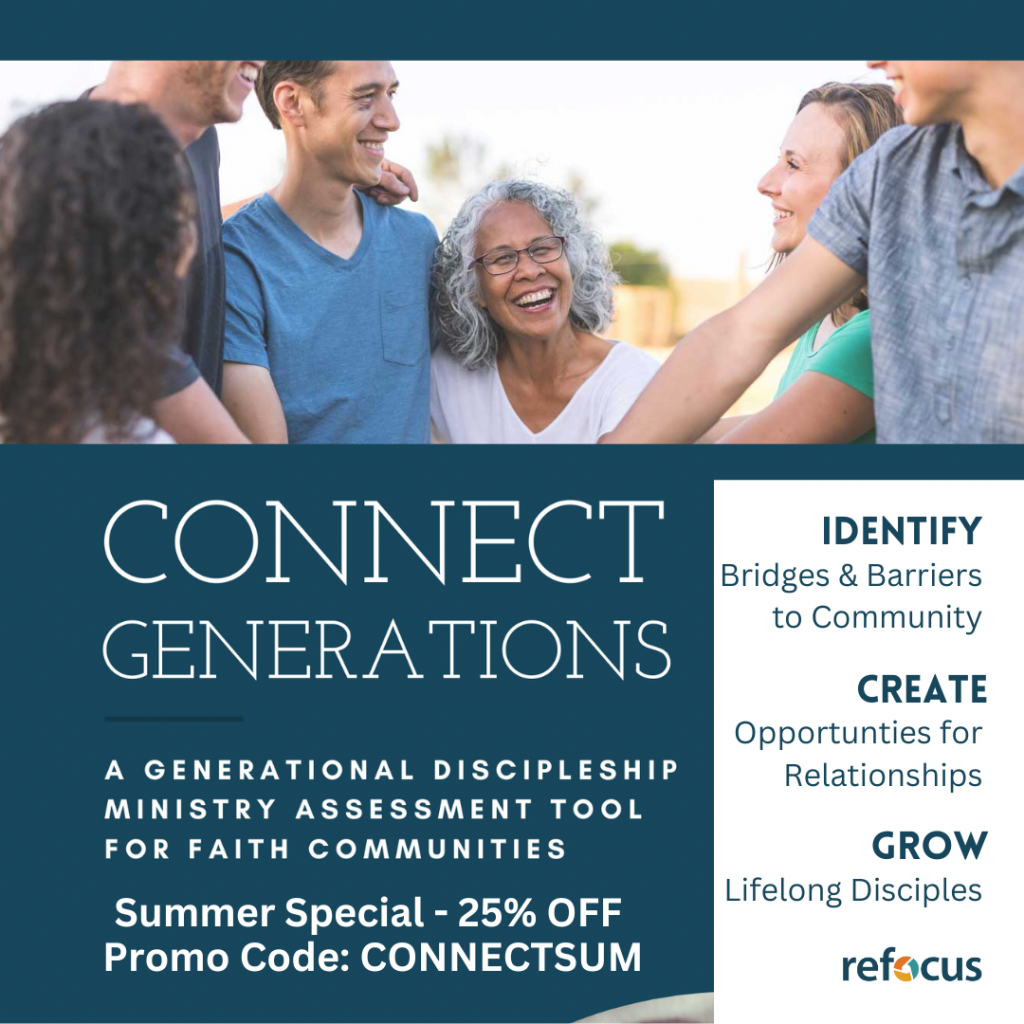“90% of our time, energy, and resources are spent reinforcing the very things that keep us apart while only 10% at most is given to the things that bring us together… and we wonder why we don’t have a strong community.”
I said that. I didn’t mean to. It wasn’t in the plan. But, in the course of working with a church who had come to me asking for better ways to connect generations withing their congregation, I said it.
It wasn’t said with malice or frustration. Rather, it was an observation of the facts, not just for this church, but for so many churches that I work with. And perhaps, for your church as well.

Nearly every church has a stated goal of creating community. Community has become a buzz word in this culture because we all know we need it and there are less and less places to find it. Churches have traditionally functioned as a “third place” in society where people from different homes and occupations gather, and are generally quick to say “Find community here!” It makes sense theologically, it meets a need sociologically, and it promises a place of knowing and belonging.
But, have we followed through on the commitment we’ve made? Do we create a community? Or do we create several small communities that occupy the same space on a given morning?
The Oxford dictionary defines community as “a feeling of fellowship with others, as a result of sharing common attitudes, interests, and goals.” Fellowship, shared goals, common attitudes…are these the ideals we offer in our churches?
The Atlantic recently published an article entitled “The Misunderstood Reason Millions of Americans Stopped Going to Church” – guess what the reason was? Community, or lack thereof. Carey Nieuwhof states one reason for people leaving church is an emphasis on consumption over connection (Source). Lifeway Research says much the same thing noting that one major reason people leave church is because they never felt connected in the first place (Source).
There are a few ways we might evaluate this and see if we are indeed creating a holistic community within our congregation. One way would be to simply ask various members of different ages if they feel like they are part of this type of community. But, there are some other less subjective ways to evaluate our effectiveness as well.
- The Budget – One place we can look is at the budget. Our expenditures can help us to see if we are investing in things that bring us together or things that separate us into different smaller communities within the church. How much is spent on age-specific or generation-specific activities, curriculum, programming, room space, etc as compared to what is spent on joint ventures that incorporate the whole congregation? What are the “all together” things and how do they show up in the annual expenditures of the congregation?
- The Schedule – Another interesting observation is our schedule. Many churches have multiple services and programming options available at different times of the day. Consider the opportunities for the church to gather as one; how often do those opportunities exist and how is the time utilized when everyone is together?
- The Staff Meeting – I have had the opportunity to serve on multiple pastoral staff teams and one thing they all had in common was the weekly staff meeting. For most of them, the vast majority of the time was spent discussing the Sunday morning schedule, planning the sermon and worship, discussing congregational health through attendance and giving, and hearing reports from age-specific ministries. While we did spend some time talking about ways to bring the congregation together and building a discipling community, the majority of our time and energy was spent on things that would reach the congregations in part but not in whole.
- The Mission – Every church has a mission statement, usually found on their website and their bulletin on Sunday morning. The mission statement is supposed to help the congregation gather around those shared values, interests, and goals mentioned in our definition of community. But often that mission statement is not even known by the majority of the congregation or by entire generations (kids and youth primarily) which makes it difficult for the mission of the church to be conducive to building community.
- The Building – Another place to observe community is by looking at the ratio of common spaces to age-specific spaces within a church. Where can the whole congregation gather? How accessible are those spaces to the congregation? How often are those spaces used? How much of the church building is set aside for age-specific use (hallways, classrooms, wings, and in some cases, entire buildings)?
This is a short list. We haven’t discussed outreach and service projects, communication and technology, leadership and ministry boards within the church, etc. And one might rightly argue that some of these spaces, places, and roles need to be age-specific or not available to the whole community. However, let’s go back to that initial statement: “90% of our time, energy, and resources are spent reinforcing the very things that keep us apart while only 10% at most is given to the things that bring us together… and we wonder why we don’t have a strong community.”
What if we flipped that on its head? Or at the very least made it 50-50? Or even 60-40? What if we tipped the scales ever so slightly in the direction of together rather than so heavily weighting our time apart?
If this strikes a chord with you, I would remind us that it takes time to turn a ship. If you turn a ship too fast, it will tip over and sink. But if you take your time, patiently leaning into an ever-widening turn, it will eventually change direction. What if at the next staff meeting or budget planning, we leaned every so slightly towards more together, less apart discussions?
The felt need of community is very real. And the church is the place where it can happen. But only if we are willing to shift our focus, put our money where our mouth is, and build it.
Connect Generations Coaching
A One-Time 60-Minute Intensive Coaching Experience that will transform your ministry.
Connect Generations Coaching is an intensive coaching experience that uses a research-based ministry assessment tool designed for churches to complete in less than a week. This unique coaching experience offers specific insight into the barriers and bridges to connect generations and bring your community together.
“This experience allowed me to review how the church needs to break down the barriers and all multi-generational relationship to happen. We did ourselves a disservice by dividing out the generations. We missed opportunities to naturally develop relationships that lead to discipleship and mentorship” – Pastor in Texas
Family Faith Formation: Fill Your Toolbox
The heart of Family Faith Formation is families spending time together around the Word of God within the context of the larger faith community.

Many parents express frustration about the lack of support and equipping they experience when it comes to leading their kids spiritually at home. Churches often encourage parents that they are the ones who are called by God to disciple their kids but frequently don’t provide the training, experience and resources needed for them to feel adequately prepared for that work.
Our Fill Your Toolbox curriculum gives parents what they need and churches what they desire. Each block contains five lessons focused on introducing, learning, and practicing specific discipleship strategies.

Christina Embree is the founder and director of ReFocus Ministry. She holds a masters in ministry focused on Children, Youth, and Family Ministry and a doctorate in spiritual formation with a focus on age segregation and intergenerational ministry. In addition to coaching churches of multiple denominations and traditions all around the globe, Christina serves as the Minister of Generational Discipleship for the Great Lakes Conference of the Brethren in Christ and as a pastor at Plowshares Brethren in Christ in Lexington, Kentucky. She is widely recognized as a speaker and author in the areas of generational discipleship, intergenerational ministry, and family ministry. As the mother of three children, she is familiar with the challenges of faith at home and pastoral ministry. She along with her husband Luke share a love for the church, their community, and the global work of peace and restoration through Jesus.



